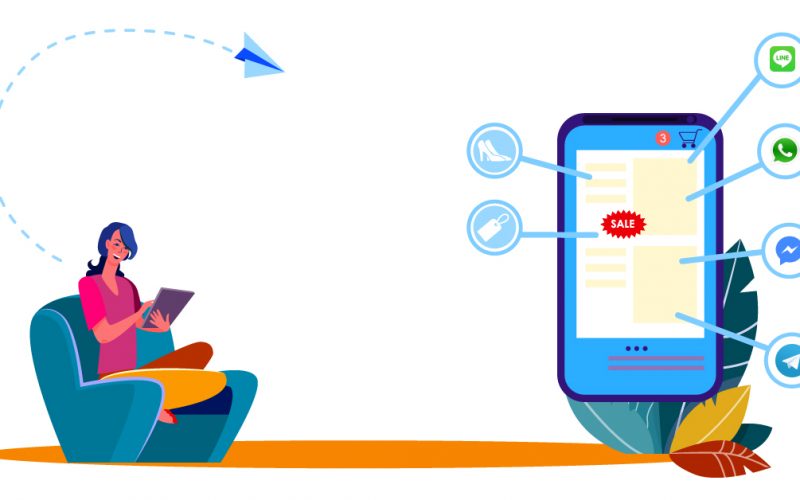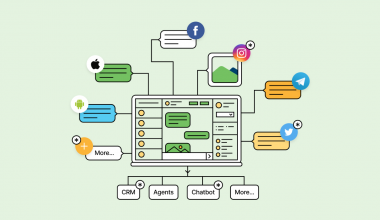There is no doubt that messaging apps have become a necessity for most people on a daily basis, whether it is to communicate with someone across the world or to create and promote a business.
Today, messaging apps (including WhatsApp, Facebook Messenger,Telegram Line and more) have eclipsed social media in both total users and growth rates.This year, the total number of messaging app users worldwide will increase by 12.1% to 2.52 billion people, we estimate. Growth will slow to 7.3% next year, reaching 2.70 billion users.
Messaging is more than just a way of sending free text messages to your friends. It’s also a different communication paradigm compared to other channels like email, SMS, and phone call.
Social media and mobile messaging completely dominate how today’s people use their phones. On top of that, mobile messaging platforms are already dominant in terms of both overall communication channels and application usage. Messaging apps are becoming a preferred means of communication.
According to eMarketer, 1.4 billion consumers used messaging apps in 2015 which is up 31.6% from 2014, and that number is expected to hit 2,9 billion by 2019. WhatsApp and Facebook Messenger both grew as fast as the core Facebook platform though, with the number of people using each messenger app up by 30 percent year on year. With over 1.3 billion users, WhatsApp is the largest messaging app in the world and it’s expected to reach 1.75 billion users by 2020.
In Indonesia, messaging applications such as Whatsapp, Line, and Facebook Messenger, are standing high on the top 10 of most downloaded mobile apps and also ranked high as apps with the highest monthly active users.
Conversational Commerce
As we see, people around the world are using messaging apps not only to chat with friends but also to connect with brands. Now, people are increasingly relying on messaging apps for all forms of communication, whether it is personal, business, or commerce, such as to browse products, watch content, select services, and even complete payment processes, all without having to call or email. Everything is possible within the messaging app.
Thus, these activities are creating a new norm in business and commerce as Chris Messina stated in his writing on Medium about conversational commerce. Messina explained conversational commerce as a shift in which businesses leverage on the power of social messengers for customer communication.
He also added that conversational commerce is about delivering convenience, personalization and decision support while people are on the go, with only partial attention to spare.
Conversational commerce makes interactions between brands and customers easier. Consumers are able to chat with company representatives, get customer support, ask questions, get personalized recommendations, read reviewsz and purchase, all from within messaging apps. With conversational commerce, the consumer engages in this interaction with a company representative, chatbot, or a mix of both.
Also read: “ A Way to Connect Better with Telegram for Business “
Nowadays, many businesses are using the potential of messaging apps as their main channel to engage with the customer so that customers no longer need to toggle back and forth between text conversations and websites to gather information and make purchases.
By reducing the steps required to complete a process, messaging apps are able to shorten the distance between prospect and purchase, thus decreasing bounce rates, as prospects mostly didn’t continue their transactions due to unresponsive and complicated customer service flows.
By doing this, customers can ask for support, take advantage of deals, and browse various stores within chat apps. These customer services offer customers a variety of options, generally in a question-and-answer format with the ability to complete tasks without ever leaving their messaging application.
In order to make this whole process sleek and simple, companies need to consider the implementation of multiple channels in customer service. Moreover, customer service is not just a matter of answering calls and responding to complaints but also how to increase engagement by delivering the same experience of communication because communicating is part of the human experience. Conversational commerce is just the next step in making our everyday online interactions a bit more humane.
Omni-Channel Customer Service
In a recent research conducted by Periscope, 78% of retailers admitted that their consumers do not have a unified brand experience and 45% of them also say that progress isn’t happening fast enough. For some reasons, businesses want to deliver unified messages and brand experiences to their customers but are still not sure how to implement it.
In order to create the same experience for customers, businessee need to consider optimizing the multiple channels they have by committing to provide consistent, yet unique and contextual, brand experiences across multiple customer-aware touch points, including web and mobile. This is also what we call it as omni-channel customer service chat.
Also read: “ Optimizing WhatsApp Use for Business “
By elevating the unique customer touch-points, businesses can maximize on any interaction with customers. To do that, companies need to allow consumers to purchase from wherever they are, while communicating in a way that is in tune with why they use a given channel and showing awareness of the individual stage in the customer life-cycle.
With today’s tech-savvy customers, omni-channel has become more than just a “nice to have” strategy; it’s now a basic requirement for customer service. Customer experience through customer service is important to build customers’ perception of how your company treats them.
These perceptions affect their behaviors and build memories and feelings and may drive their loyalty. In other words, if customers like you, they are going to continue doing business with you and recommend you to others. Therefore, to make customers like you, you should treat them very well to deliver unified experiences that will entice their loyalty.
According to Aberdeen Group, companies that provide a consistent service quality across multiple channels retain 89% of their customers, whereas companies that do not provide a consistent quality are only able to retain 33%.
Consumers expect their brand interactions to be seamless, no matter when, where or what type of channel they use to engage brands. Users need to have the same experience across different channels. For example, customer experience through Facebook Messenger should be consistent with LINE and the website.
Thus, it’s not easy for businesses to engage their customers via multiple channels, without any help from third-party apps. Qiscus as a chat provider service has just launched its omni-channel customer service dashboard called Qiscus Multichannel Chat so you can easily manage your company’s customer service chat lines such as Whatsapp Facebook Messenger, LINE, and web widget in one simple dashboard. The application of this omni-channel customer service in your business is one of the best ways to fulfill customer expectations.

By using the Omni-channel system, companies can generate customer service chat apps that can connect companies customers via various different channels. All companies need to do is to operate a single platform to greatly enhance its efficiency.
However, keep in mind that omni-channel customer service is also a double-edged knife in some circumstances. Besides its potential to reach broader customers, omni-channel also has a negative side if businesses are unable to deliver the same experience across the channels. In order to make things as they are intended to be, businesses need a partner who is expert in the omni-channel customer service to implement the strategy.
Also read: “ Use Cases of Successful Marketing on Facebook Messenger “
Omnichannel is more than offering customers the ability to contact a company via every channel under the sun; it’s about connecting the dots and ensuring each method and mode of communication is integrated into the whole customer’s journey. By integrating text, images and instant messaging to provide a unified brand experience so that customer can switch between multiple channels yet still experience the same quality of service.
Omni-channel customer service chats are able to give you the opportunity to serve your customers in a variety of ways that are not only convenient and effective, but which also boost your brand’s image and credibility. In the conversational commerce era, the most important thing to emphasize on is how businesses are able to provide the same positive experience across channels as expected by customers.



